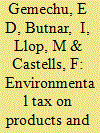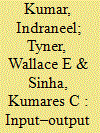|
|
|
Sort Order |
|
|
|
Items / Page
|
|
|
|
|
|
|
| Srl | Item |
| 1 |
ID:
116719


|
|
|
|
|
| Publication |
2012.
|
| Summary/Abstract |
The main aim of this work is to define an environmental tax on products based on their carbon footprint. We examine the relevance of life cycle analysis (LCA) and environmentally extended input-output analysis (EIO) as methodological tools for identifying the emission intensities on which the tax is based. The price effects of the tax and the policy implications of considering non-CO2 greenhouse gases (GHG) are also analyzed. The results from the case study on pulp production show that the environmental tax rate based on LCA (1.8%) is higher than both EIO approaches (0.8 and 1.4% for product and industry, respectively), but they are of the same order of magnitude. Although LCA is more product specific and provides a more detailed analysis, we recommend EIO as a more relevant approach to applying an economy-wide environmental tax. If an environmental tax were applied to non-CO2 GHG instead to CO2 alone, the tax would greatly affects sectors such as agriculture, mining of coal, extraction of peat, and food. Therefore, it is worthwhile for policy-makers to pay attention to the implications of considering either a CO2 tax or a global GHG emissions tax in order to make their policy measures effective and meaningful.
|
|
|
|
|
|
|
|
|
|
|
|
|
|
|
|
| 2 |
ID:
109312


|
|
|
|
|
| Publication |
2011.
|
| Summary/Abstract |
A small fleet of classic London Taxis (Black cabs) equipped with hydrogen fuel cell power systems is being prepared for demonstration during the 2012 London Olympics.
This paper presents a Life Cycle Analysis for these vehicles in terms of energy consumption and CO2 emissions, focusing on the impacts of alternative vehicle technologies for the Taxi, combining the fuel life cycle (Tank-to-Wheel and Well-to-Tank) and vehicle materials Cradle-to-Grave.
An internal combustion engine diesel taxi was used as the reference vehicle for the currently available technology. This is compared to battery and fuel cell vehicle configurations. Accordingly, the following energy pathways are compared: diesel, electricity and hydrogen (derived from natural gas steam reforming).
Full Life Cycle Analysis, using the PCO-CENEX drive cycle, (derived from actual London Taxi drive cycles) shows that the fuel cell powered vehicle configurations have lower energy consumption (4.34 MJ/km) and CO2 emissions (235 g/km) than both the ICE Diesel (9.54 MJ/km and 738 g/km) and the battery electric vehicle (5.81 MJ/km and 269 g/km).
|
|
|
|
|
|
|
|
|
|
|
|
|
|
|
|
| 3 |
ID:
150786


|
|
|
|
|
| Summary/Abstract |
Wind energy is an emerging source for renewable energy. This article presents an application of the economic input–output life cycle assessment (EIO-LCA) to estimate the greenhouse gas (GHG) emissions through the life cycle of wind energy farms in a state. The EIO-LCA incorporates manufacturing, installation, operation and maintenance, and decommissioning of the wind turbine over its life cycle period. In doing so, the study demonstrates that O&M and decommissioning of infrastructure with a longer life period can be considered to assess the total environmental impacts. The life cycle costs of wind turbine installation in Indiana is used in this study. The uncertainty in wind energy production, and hence the variability in GHG emission intensities in metric tons per gigawatt hour (GWh), is demonstrated by using the Monte Carlo simulation. The research finds that wind energy production is not entirely GHG emission-free if all the costs and life cycle stages are considered. Emission estimates have uncertainty, and O&M and decommissioning can add up to 200 metric tons of GHG emissions in CO2e per wind turbine life cycle. The regional EIO-LCA can be a helpful tool to determine strategies for state compliance to initiatives, such as the Clean Power Plan.
|
|
|
|
|
|
|
|
|
|
|
|
|
|
|
|
| 4 |
ID:
109329


|
|
|
|
|
| Publication |
2011.
|
| Summary/Abstract |
The main aim of this study is to evaluate whether the potential transformation of the existing sugar plants of Northern Greece to modern bioethanol plants, using the existing cultivations of sugar beet, would be an environmentally sustainable decision. Using Life Cycle Inventory and Impact Assessment, all processes for bioethanol production from sugar beets were analyzed, quantitative data were collected and the environmental loads of the final product (bioethanol) and of each process were estimated. The final results of the environmental impact assessment are encouraging since bioethanol production gives better results than sugar production for the use of the same quantity of sugar beets. If the old sugar plants were transformed into modern bioethanol plants, the total reduction of the environmental load would be, at least, 32.6% and a reduction of more than 2 tons of CO2e/sugar beet of ha cultivation could be reached. Moreover bioethanol production was compared to conventional fuel (gasoline), as well as to other types of biofuels (biodiesel from Greek cultivations).
|
|
|
|
|
|
|
|
|
|
|
|
|
|
|
|
| 5 |
ID:
111359


|
|
|
|
|
| Publication |
2012.
|
| Summary/Abstract |
Electric drive vehicle technologies are being considered as possible solutions to mitigate environmental problems and fossil fuels dependence. Several studies have used life cycle analysis technique, to assess energy use and CO2 emissions, addressing fuels Well-to-Wheel life cycle or vehicle's materials Cradle-to-Grave. However, none has considered the required infrastructures for fuel supply. This study presents a methodology to evaluate energy use and CO2 emissions from construction, maintenance and decommissioning of support infrastructures for electricity and fossil fuel supply of vehicles applied to Portugal case study. Using Global Warming Potential and Cumulative Energy Demand, three light-duty vehicle technologies were considered: Gasoline, Diesel and Electric. For fossil fuels, the extraction well, platform, refinery and refuelling stations were considered. For the Electric Vehicle, the Portuguese 2010 electric mix, grid and the foreseen charging point's network were studied. Obtained values were 0.6-1.5 gCO2eq/km and 0.03-0.07 MJeq/km for gasoline, 0.6-1.6 gCO2eq/km and 0.02-0.06 MJeq/km for diesel, 3.7-8.5 gCO2eq/km and 0.06-0.17 MJeq/km for EV. Monte Carlo technique was used for uncertainty analysis. We concluded that EV supply infrastructures are more carbon and energetic intensive. Contribution in overall vehicle LCA does not exceed 8%.
|
|
|
|
|
|
|
|
|
|
|
|
|
|
|
|
| 6 |
ID:
104931


|
|
|
|
|
| Publication |
2011.
|
| Summary/Abstract |
Malaysia's transportation sector accounts for 41% of the country's total energy use. The country is expected to become a net oil importer by the year 2011. To encourage renewable energy development and relieve the country's emerging oil dependence, in 2006 the government mandated blending 5% palm-oil biodiesel in petroleum diesel. Malaysia produced 16 million tonnes of palm oil in 2007, mainly for food use. This paper addresses maximizing bioenergy use from oil-palm to support Malaysia's energy initiative while minimizing greenhouse-gas emissions from land-use change. When converting primary and secondary forests to oil-palm plantations between 270-530 and 120-190 g CO2-equivalent per MJ of biodiesel produced, respectively, is released. However, converting degraded lands results in the capture of between 23 and 85 g CO2-equivalent per MJ of biodiesel produced. Using various combinations of land types, Malaysia could meet the 5% biodiesel target with a net GHG savings of about 1.03 million tonnes (4.9% of the transportation sector's diesel emissions) when accounting for the emissions savings from the diesel fuel displaced. These findings are used to recommend policies for mitigating GHG emissions impacts from the growth of palm oil use in the transportation sector.
|
|
|
|
|
|
|
|
|
|
|
|
|
|
|
|
| 7 |
ID:
103347


|
|
|
|
|
| Publication |
2011.
|
| Summary/Abstract |
In Europe, buildings tend to be equipped with individual air conditioners, which constitute a fast growing electrical end-use. In this context, this study aims to assess the environmental impacts of European individual air conditioners and to analyse policy strategies to reduce these impacts. After analysing the European context concerning individual air conditioners, the environmental impacts of European air conditioners are assessed using a Life Cycle Analysis approach. The following step consists in studying, both technically and economically, different improvement options aiming at reducing the environmental impacts of these appliances. These results, obtained at the product level, are then generalised at the European level and different policy measures are defined and analysed. The main conclusion is that the implementation of a Minimum Energy Performance Standard based on Least Life Cycle Costs could save up to 49 TWh and 20 MtCO2-eq in 2020 and be economically beneficial to the European end-user.
|
|
|
|
|
|
|
|
|
|
|
|
|
|
|
|
| 8 |
ID:
118844


|
|
|
|
|
| Publication |
2013.
|
| Summary/Abstract |
Agricultural biofuels require the use of scarce land, and this land has opportunity cost. We explore the objective function of a social planner who includes a land constraint in the optimization decision to minimize environmental cost. The inclusion of this land constraint in our optimization model motivates the measurement of emissions on a per-hectare basis. Switchgrass and corn are modeled as competing alternatives to show how the inclusion of a land constraint can influence life cycle rankings and alter policy conclusions. With land use unconstrained, ethanol produced from switchgrass is always an optimal feedstock relative to ethanol produced from corn. With land use constrained, however, our results show that it is unlikely that switchgrass would be optimal in the midwestern United States, but may be optimal in southern states if carbon is priced relatively high. Whether biofuel policy advocates for one feedstock over another should consider these contrasting results.
|
|
|
|
|
|
|
|
|
|
|
|
|
|
|
|
|
|
|
|
|